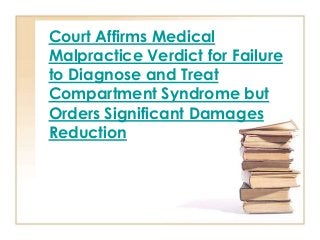
Court affirms medical malpractice verdict for failure to
- 1. Court Affirms Medical Malpractice Verdict for Failure to Diagnose and Treat Compartment Syndrome but Orders Significant Damages Reduction
- 2. By John Hochfelder on January 7, 2013 Posted in Amputation Injuries, Medical Malpractice On September 24, 2000, Thomas Burke fell from his wheelchair and injured his left foot. Mr. Burke, then 57 years old, had been afflicted with progressive multiple sclerosis for 20 years and had been wheelchair-bound since the mid- 1990s. A week after he fell, Burke consulted with the first of several doctors about continuing leg pain. Unfortunately, he developed compartment syndrome and on October 11, 2000 – less than three weeks after he fell – Burke’s left leg had to be surgically amputated below his knee. Compartment- Syndrome Compartment syndrome is a painful condition that occurs when pressure within the muscles builds to dangerous levels.
- 3. If acute, it is a medical emergency requiring a fasciotomy in which the surrounding skin and fascia (connective tissue) are cut open and away to relieve the pressure. Burke sued several physicians claiming malpractice but all were dismissed from his suit except an orthopedic surgeon, Wesley V. Carrion, M.D., who treated him one time, 11 days after the fall. Burke claimed that the orthopedic surgeon should have diagnosed acute compartment syndrome (“ACS”) and performed a fasciotomy. The defense contended that ACS is only acute for about seven hours after an injury and that thereafter it is medically inadvisable to operate. The jury disagreed and on May 6, 2008 they returned a verdict finding the defendant liable.
- 4. The jury also: (a) assessed pain and suffering damages in the sum of $1,500,000 ($500,000 past – eight years, $1,000,000 future – 17 years) and (b) awarded plaintiff’s wife loss of services damages in the sum of $750,000 ($250,000 past, $500,000 future). On appeal, in Burke v. Carrion (2d Dept. 2012), the liability finding and the pain and suffering damages awards were affirmed; however, the loss of services awards were slashed to $20,000 ($15,000 past, $5,000 future). Plaintiff argued, successfully, that the pain and suffering awards should be sustained because, even though plaintiff was wheelchair bound for many years he had been “fiercely independent” and able physically in many respects (e.g., prepared his own lunches, washed dishes and drove his car) but after the amputation he:
- 5. • was essentially immobilized in the hospital and in rehabilitation for approximately one year • was without a prosthesis for a year and during that time had to be moved by a Hoyer lift • underwent nine surgical procedures (three major surgeries on his lower leg and numerous debridements) • sustained global degeneration – the loss of most muscle strength and coordination throughout his body • became totally dependent on others for activities of daily living such as wheelchair transfers, showering and toileting
- 6. Hoyer Lift The defense argued, unsuccessfully, that the pain and suffering awards were excessive, and the 17 year future period too long, because of a host of pre-existing conditions Mr. Burke was already suffering from including: progressive MS, strokes, Bell’s Palsy, seizures heart conditions and depression. Although the appellate court affirmed the pain and suffering damages, it ordered a drastic reduction of the plaintiff’s wife’s loss of spousal services and consortium verdict: from $750,000 to $20,000. Plaintiff argued on appeal that his wife’s derivative award was proper because Mr. Burke had, before the amputation, been “a loving husband and enjoyable partner” with “an intimate marriage [that] was transformed into a sad existence of caretaking, worry, and lack of
- 7. normalcy and support.” Additionally, plaintiff argued that he could no longer perform any household chores. • The defense argued, successfully, that there was insufficient evidence to support any significant loss of services award claiming that strokes before the amputation left Mr. Burke unable to handle the household finances, transfer from one spot to another or drive a car and that he was already essentially immobile and in need of outside physical assistance. • Inside Information: On May 24, 2009, just a year after the verdict was rendered, Thomas Burke died from brain cancer, a cause unrelated to his leg or malpractice claims. Under New York law requiring large future pain and suffering verdicts to be paid out over many years (and
- 8. discontinued in the event of death), almost all of the future pain and suffering damages in this case in excess of $250,000 will not be due. • Two months before the verdict in Burke v. Carrion, a different jury exonerated Dr. Carrion in a different case, Mistretta v. Carrion. In that case, a 15 year old who underwent a derotational osteotomy claimed that she developed compartment syndrome because peroneal nerve compression had not been addressed intra-operatively. The jury rendered a defense verdict finding no malpractice.
- 9. POSTED BY ATTORNEY RENE G. GARCIA: For more information:- Some of our clients have suffered this kind of injuries due to a serious accident. The Garcia Law Firm, P.C. was able to successfully handle these types of cases. For a free consultation please call us at 1-866- SCAFFOLD or 212-725-1313. http://www.newyorkinjurycasesblog.com/
